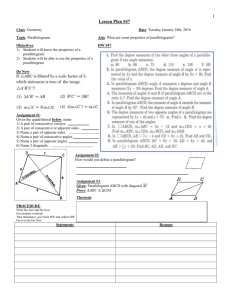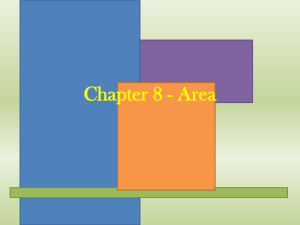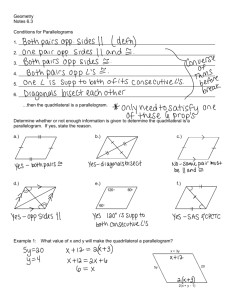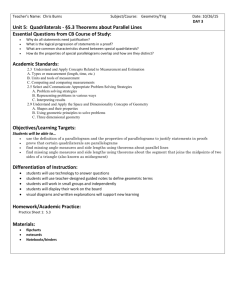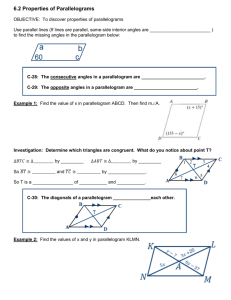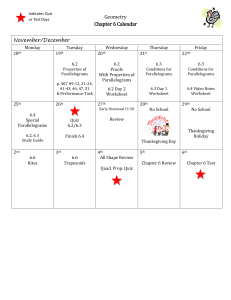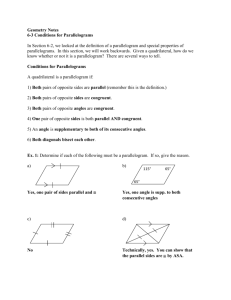6-3 - Images
advertisement
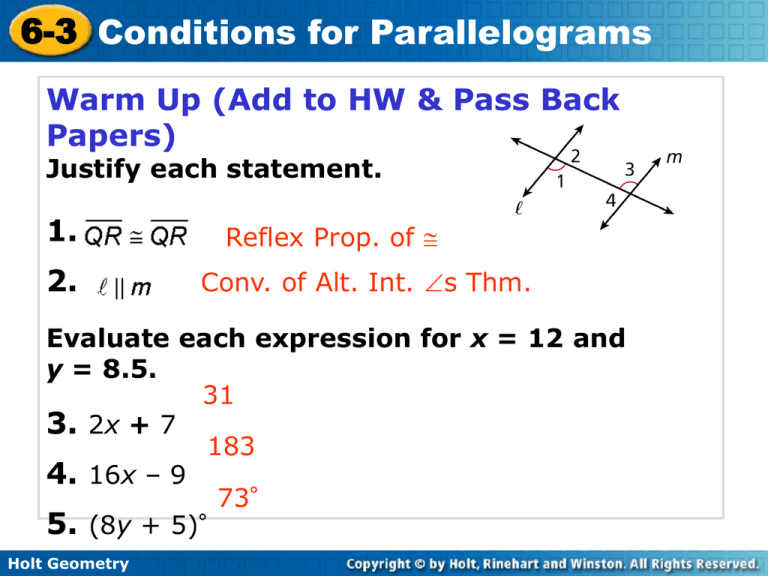
6-3 Conditions for Parallelograms Warm Up (Add to HW & Pass Back Papers) Justify each statement. 1. 2. Reflex Prop. of Conv. of Alt. Int. s Thm. Evaluate each expression for x = 12 and y = 8.5. 31 3. 2x + 7 183 4. 16x – 9 73° 5. (8y + 5)° Holt Geometry 6-3 Conditions for Parallelograms 6-3 Conditions for Parallelograms Holt Geometry Holt Geometry 6-3 Conditions for Parallelograms Holt Geometry 6-3 Conditions for Parallelograms Holt Geometry 6-3 Conditions for Parallelograms Example 1A: Verifying Figures are Parallelograms Show that JKLM is a parallelogram for a = 3 and b = 9. Step 1 Find JK and LM. JK = 15a – 11 Given LM = 10a + 4 Substitute JK = 15(3) – 11 = 34 and simplify. LM = 10(3)+ 4 = 34 Holt Geometry 6-3 Conditions for Parallelograms Example 1A Continued Step 2 Find KL and JM. KL = 5b + 6 KL = 5(9) + 6 = 51 Given JM = 8b – 21 Substitute and simplify. JM = 8(9) – 21 = 51 Since JK = LM and KL = JM, JKLM is a parallelogram by Theorem 6-3-2. Holt Geometry 6-3 Conditions for Parallelograms Example 1B: Verifying Figures are Parallelograms Show that PQRS is a parallelogram for x = 10 and y = 6.5. mQ = (6y + 7)° Given Substitute 6.5 for y mQ = [(6(6.5) + 7)]° = 46° and simplify. mS = (8y – 6)° Given mS = [(8(6.5) – 6)]° = 46° Substitute 6.5 for y and simplify. mR = (15x – Given Substitute 10 for x 16)° mR = [(15(10) – 16)]° = 134° and simplify. Holt Geometry 6-3 Conditions for Parallelograms Example 1B Continued Since 46° + 134° = 180°, R is supplementary to both Q and S. PQRS is a parallelogram by Theorem 6-3-4. Holt Geometry 6-3 Conditions for Parallelograms Example 2A: Applying Conditions for Parallelograms Determine if the quadrilateral must be a parallelogram. Justify your answer. Yes. The 73° angle is supplementary to both its corresponding angles. By Theorem 6-3-4, the quadrilateral is a parallelogram. Holt Geometry 6-3 Conditions for Parallelograms Example 2B: Applying Conditions for Parallelograms Determine if the quadrilateral must be a parallelogram. Justify your answer. No. One pair of opposite angles are congruent. The other pair is not. The conditions for a parallelogram are not met. Holt Geometry 6-3 Conditions for Parallelograms Check It Out! Example 2b Determine if each quadrilateral must be a parallelogram. Justify your answer. No. Two pairs of consective sides are congruent. None of the sets of conditions for a parallelogram are met. Holt Geometry 6-3 Conditions for Parallelograms Helpful Hint To say that a quadrilateral is a parallelogram by definition, you must show that both pairs of opposite sides are parallel. Holt Geometry 6-3 Conditions for Parallelograms Example 3A: Proving Parallelograms in the Coordinate Plane Show that quadrilateral JKLM is a parallelogram by using the definition of parallelogram. J(–1, –6), K(–4, –1), L(4, 5), M(7, 0). Find the slopes of both pairs of opposite sides. Since both pairs of opposite sides are parallel, JKLM is a parallelogram by definition. Holt Geometry 6-3 Conditions for Parallelograms Holt Geometry 6-3 Conditions for Parallelograms Example 4: Application The legs of a keyboard tray are connected by a bolt at their midpoints, which allows the tray to be raised or lowered. Why is PQRS always a parallelogram? Since the bolt is at the midpoint of both legs, PE = ER and SE = EQ. So the diagonals of PQRS bisect each other, and by Theorem 6-3-5, PQRS is always a parallelogram. Holt Geometry 6-3 Conditions for Parallelograms Check It Out! Example 4 The frame is attached to the tripod at points A and B such that AB = RS and BR = SA. So ABRS is also a parallelogram. How does this ensure that the angle of the binoculars stays the same? Since ABRS is a parallelogram, it is always true that . Since AB stays vertical, RS also remains vertical no matter how the frame is adjusted. Therefore the viewing never changes. Holt Geometry 6-3 Conditions for Parallelograms Lesson Quiz: Part I 1. Show that JKLM is a parallelogram for a = 4 and b = 5. JN = LN = 22; KN = MN = 10; so JKLM is a parallelogram by Theorem 6-3-5. 2. Determine if QWRT must be a parallelogram. Justify your answer. No; One pair of consecutive s are , and one pair of opposite sides are ||. The conditions for a parallelogram are not met. Holt Geometry 6-3 Conditions for Parallelograms Lesson Quiz: Part II 3. Show that the quadrilateral with vertices E(–1, 5), F(2, 4), G(0, –3), and H(–3, –2) is a parallelogram. Since one pair of opposite sides are || and , EFGH is a parallelogram by Theorem 6-3-1. Holt Geometry
